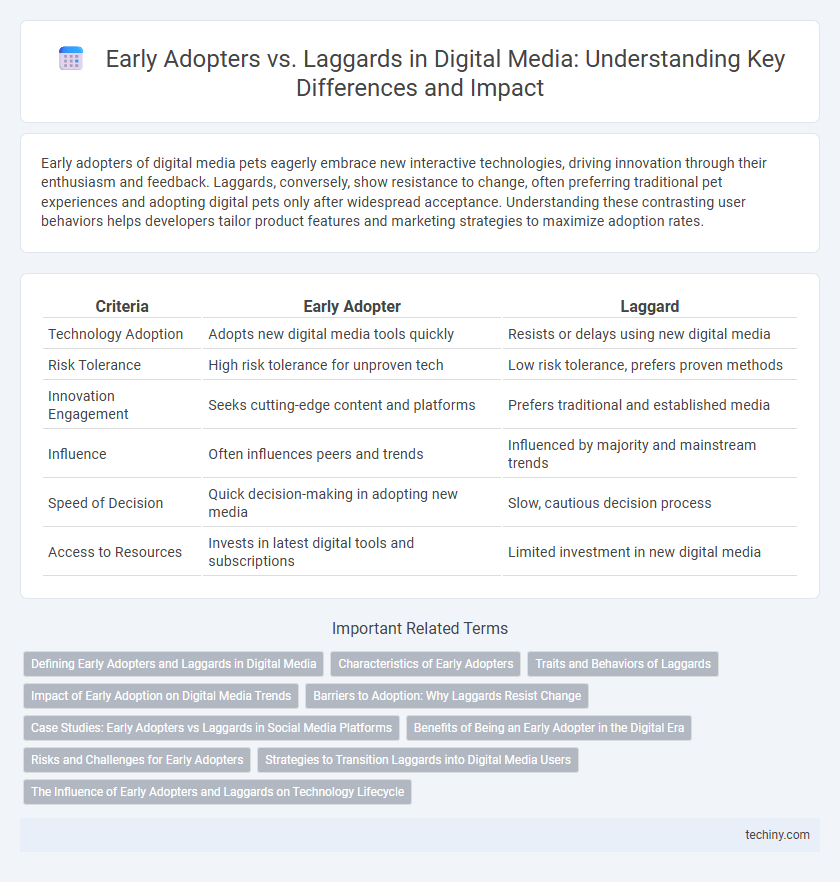Early adopters of digital media pets eagerly embrace new interactive technologies, driving innovation through their enthusiasm and feedback. Laggards, conversely, show resistance to change, often preferring traditional pet experiences and adopting digital pets only after widespread acceptance. Understanding these contrasting user behaviors helps developers tailor product features and marketing strategies to maximize adoption rates.
Table of Comparison
| Criteria | Early Adopter | Laggard |
|---|---|---|
| Technology Adoption | Adopts new digital media tools quickly | Resists or delays using new digital media |
| Risk Tolerance | High risk tolerance for unproven tech | Low risk tolerance, prefers proven methods |
| Innovation Engagement | Seeks cutting-edge content and platforms | Prefers traditional and established media |
| Influence | Often influences peers and trends | Influenced by majority and mainstream trends |
| Speed of Decision | Quick decision-making in adopting new media | Slow, cautious decision process |
| Access to Resources | Invests in latest digital tools and subscriptions | Limited investment in new digital media |
Defining Early Adopters and Laggards in Digital Media
Early adopters in digital media are tech-savvy individuals who swiftly embrace innovative platforms and tools, driving early trends and influencing broader audience engagement. Laggards represent the segment resistant to change, often adopting new digital media technologies much later, typically due to skepticism or lack of familiarity. Understanding these groups aids in tailoring marketing strategies to optimize product adoption rates across diverse consumer behaviors.
Characteristics of Early Adopters
Early adopters in digital media demonstrate a high level of tech-savviness and seek innovative content or platforms before mass acceptance. They exhibit strong influence in their social circles, acting as trendsetters and providing critical feedback for product improvements. Their willingness to embrace new technologies early accelerates digital media adoption curves and shapes market dynamics.
Traits and Behaviors of Laggards
Laggards in digital media exhibit a strong resistance to change, often relying on traditional channels and outdated technologies long after new innovations have emerged. They tend to adopt digital tools only when absolutely necessary, driven by external pressure rather than intrinsic motivation. Their cautious behavior, skepticism about digital trends, and preference for proven methods significantly delay the adoption of emerging media platforms.
Impact of Early Adoption on Digital Media Trends
Early adopters accelerate the diffusion of innovative digital media technologies by embracing new platforms and content formats sooner than others, driving rapid user engagement and feedback loops. Their proactive adoption influences mainstream trends, encouraging developers to prioritize features that resonate with early audiences, thereby shaping the evolution of social media algorithms and streaming services. Brands targeting early adopters often gain competitive advantages by capturing niche markets early, which can lead to broader acceptance and commercialization of emerging digital media innovations.
Barriers to Adoption: Why Laggards Resist Change
Laggards resist change in digital media adoption due to factors such as limited technological literacy, high perceived risks, and strong attachment to traditional methods. Financial constraints and skepticism toward new innovations further contribute to their hesitation. Understanding these barriers is crucial for tailoring strategies that encourage gradual acceptance and minimize resistance among late adopters.
Case Studies: Early Adopters vs Laggards in Social Media Platforms
Case studies in digital media reveal that early adopters of social media platforms often gain significant advantages in audience reach and brand engagement, capitalizing on novel features before competitors. Laggards typically face challenges in catching up due to established user habits and entrenched platform algorithms favoring early mover content. Research shows early adopters also tend to shape platform trends, influencing content norms and monetization opportunities, while laggards lag in adapting to evolving digital marketing strategies.
Benefits of Being an Early Adopter in the Digital Era
Early adopters in the digital era gain significant competitive advantages by accessing cutting-edge technologies before the majority, enabling faster innovation cycles and market differentiation. They benefit from enhanced customer engagement through early integration of advanced digital tools, resulting in improved brand loyalty and higher revenue potential. Early adoption also facilitates valuable insights from real-time data analytics, driving strategic decisions that optimize operational efficiency and user experience.
Risks and Challenges for Early Adopters
Early adopters in digital media face significant risks including high development costs, unproven technology reliability, and limited user acceptance that can hinder market penetration. They often encounter challenges such as rapid technological changes requiring frequent updates and potential compatibility issues with established platforms. Despite early access to innovation, these risks demand careful strategic planning to mitigate financial losses and maintain competitive advantage.
Strategies to Transition Laggards into Digital Media Users
Segmenting laggards in digital media adoption requires tailored strategies emphasizing simplicity and clear value propositions. Leveraging educational campaigns and providing hands-on support can reduce resistance and build digital literacy. Incentivizing initial engagement through exclusive content or promotions accelerates laggards' transition into active digital media users.
The Influence of Early Adopters and Laggards on Technology Lifecycle
Early adopters accelerate technology diffusion by embracing innovations during initial launch phases, often influencing mainstream acceptance through social proof and feedback loops. Laggards delay adoption due to risk aversion or limited resources, potentially hindering full market penetration and extending the maturity stage of the technology lifecycle. Understanding the behavioral dynamics of both groups enables marketers to optimize product launches and phase-out strategies effectively.
Early Adopter vs Laggard Infographic

 techiny.com
techiny.com